Sand surrounds us–and while it may seem in infinite supply, it isn’t. While overlooking a remote and pristine beach on the Gulf of California in Baja Sur, Mexico a decade ago, it dismayed me to see two men shoveling the beach sand into a truck. I knew that removing that truckload of sand, and probably eventually many more truckloads from the beach, would change that coastline forever. And not in a good way.
Currently, sand is being used up much faster than it is being replenished. Sand and gravel, collectively known as aggregate, are the most widely extracted solid materials on Earth. Each year, we use about 50 billion tons of sand and gravel–enough to build a wall almost 90 ft wide and 90 ft high (27 m x 27 m) that encircles our planet Earth. Scary. A recent report by the United Nations Environment Programme recognizes sand as a strategic resource–and one with looming challenges. The report title captures the problem: Sand and Sustainability: 10 strategic recommendations to avert a crisis (UNEP, 2022).
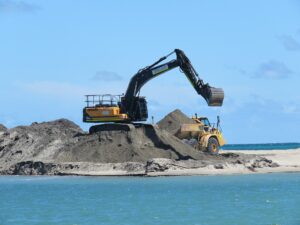
Sand mining at Tern Island Nature Reserve, Safety Bay, Western Australia (Wikimedia)
Sand All Around Us
Sand grains are smaller than gravel and larger than silt and clay, so a small grain size defines them. The composition of sand is highly variable, depending on the local bedrock and environmental setting. From light colored sand derived from granitic rocks and mostly composed of quartz (SiO2), to aragonite or calcium carbonate (CaCO3) from the shells of ancient marine creatures and coral reefs, to the iron-rich black sands of volcanic origin and beyond, there are many types of sand.
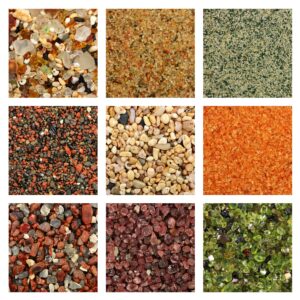
Depiction of sands: glass, dune, quartz, volcanic, biogenic coral, pink coral, volcanic, garnet, olivine. Samples are from the Gobi Desert, Estonia, Hawaii and the mainland United States. (1×1 cm each) (Wikipedia)
The greatest volume of sand by far is incorporated in the concrete used for urbanization and infrastructure construction projects—houses to roads to water treatment plants—especially in regions with developing economies. Sand is also important in:
— beach sand replacement, where the original sand eroded away, for tourist uses or for storm protection (increasingly important);
— water filtration systems to remove impurities;
— agricultural fields as a soil amendment to improve drainage;
–hydraulic fracturing, where sand is used to hold cracks open in bedrock to harvest oil and gas, for geologic sequestration of CO2 , in geothermal systems for electricity generation, and many others;
— artificial island construction in the Netherlands, Japan, Persian Gulf, and many other regions. As one example, the Palm Jemerirah, an artificial sand island in Dubai, required some 385 million tons of marine sands that were dredged from offshore sea beds in the Persian Gulf;
— sandblasting, to smooth or clean hard surfaces, etch glass, and create a worn-look in fabrics such as denim jeans;
— for playing surfaces, as in beach volleyball and on tennis courts.
But not just any type of sand will work for many of these uses—specific characteristics are required. (More about some types of sand in my blog posts: Desert Countries Import Sand? and Concrete Concerns.)
High Demand, High Profits and a Black Market
To meet the high demand for sand, it is being extracted from pits in floodplains and coastal ecosystems or dredged from shallow coastal waters and active riverbeds. These areas are vulnerable to overexploitation because of the ease in extracting and transporting the material, as well as difficulty regulating this industry. Unfortunately, a wide range of negative effects typically accompany extraction. Sand removal can lead to erosion, loss of protection against storm surges, increased flooding and landslides, saltwater intrusion into groundwater aquifers, disruption of ecosystems through increased suspended sediments, and many other negative environmental impacts. It also poses a threat to livelihoods by disrupting water supplies, agricultural production, and fisheries. In many regions, sand mining in river deltas has destroyed orchards and croplands with saltwater influx, and in coastal waters it has obliterated fish spawning grounds and shellfish beds by burying them with sediment.
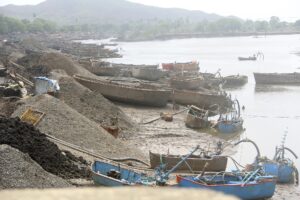
Sand mining with suction pumps; operating day and night, they can extract a large volume of sand in a short amount of time (Wikimedia)
Especially in developing countries, informal and small-scale mining operations dominate the sand industry. Environmental degradation accompanies the endeavors. As demand increases for limited supplies, prices rise, and conflicts associated with illegal mining increase. Organized criminal gangs often take over the trade. Violence related to rival groups of sand miners occur in many countries, from Mexico and Morocco to Kenya and South Africa to China and Indonesia, and beyond. In parts of India, the gangs are called the “sand mafia”, and conflicts have led to the murders of hundreds of people, including journalists, environmental activists, and government officials.
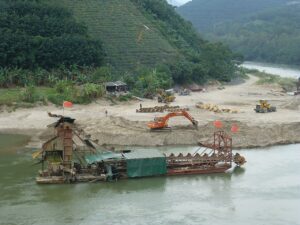
Sand mining operation on the bank of the Red River, Jinping County, China (Wikimedia)
Challenges Ahead
Balancing societal demands with sand extraction and protection efforts is a complex problem, especially because of the widespread informal and illegal aspects of sand mining. Knowledge of the issues involved ranges across resource geology, political ecology, biology, urban development and mining.
The UNEP report, Sand and Sustainability: 10 strategic recommendations to avert a crisis, stresses that the practices for sand extraction and use need to be improved. The report brings attention to “the impacts from the current state of extraction, use and (mis)management, putting forward recommendations for actions to set the global sand agenda in addressing environmental sustainability needs alongside justice, equity, technical, economic, and political considerations.” Suggested solutions include establishing ownership and access to sand resources; mapping and monitoring sand resources to allow improved decision- making, banning the landfilling of mineral waste and using recycled construction and demolition material, and requiring restoration of ecosystems and compensation for losses. We need decisive actions urgently; as the title of the UNEP report so clearly states, a crisis is approaching.
If you liked this post, please share it and/or leave a comment or question below and I will reply – thanks! And if you’d like to receive a message when I publish a new post, scroll down to the bottom of this page, and leave your email address on my website. Join now to learn more about geology, geography, culture, and history.
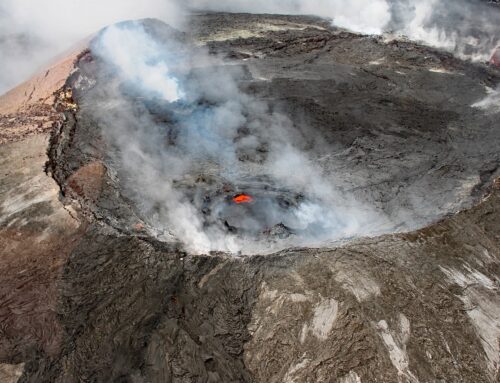

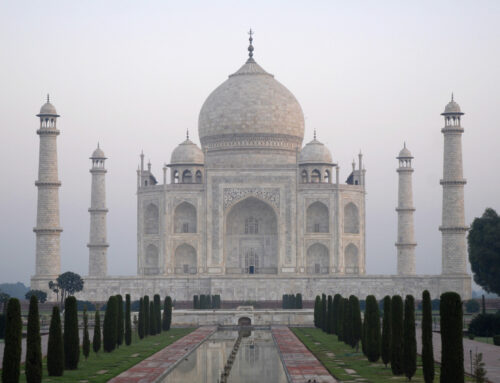
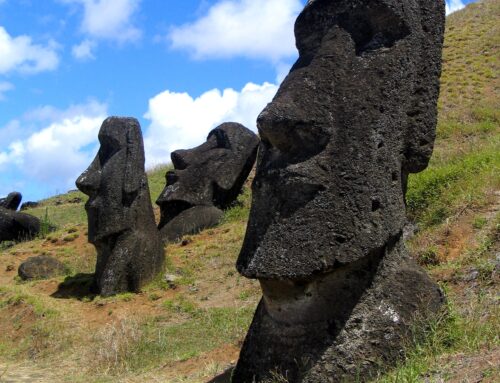
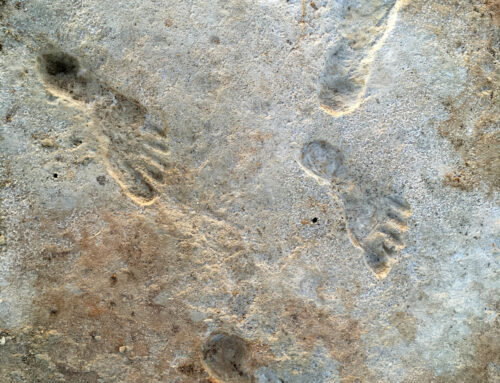
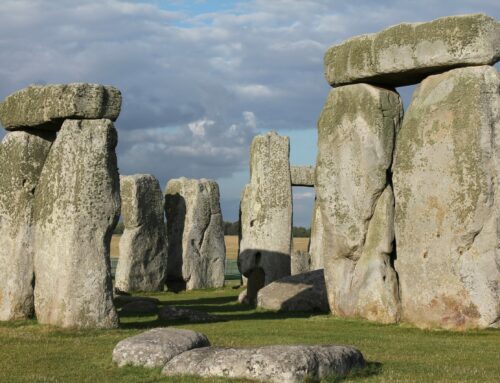
Very interesting and alarming!
Thanks, Robin!
Thank you Roseanne! When is greed self preservation?
Thanks, Rich. We live in interesting times — and a complicated world!
I liked seeing the many close-ups of sand types. So beautiful. I have a jar of sand from the Kalahari Desert (white) and the dunes in Namibia (red).
Nice to hear – thanks, Wayne! I have a jar of black sand from Hawaii, and a small collection of garnet grains from Big Sur beaches on the central California coast.
Roseanne,
I had no idea or comprehension about these problems. Thank you so much for your educational manner.
Thank you, Karen!